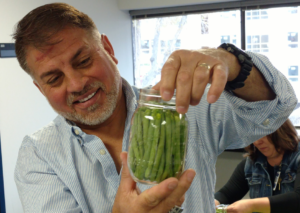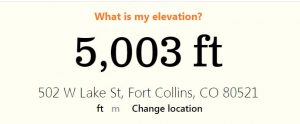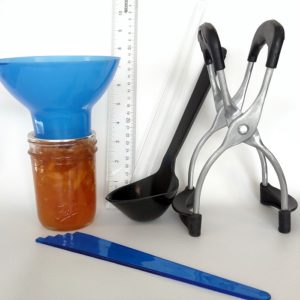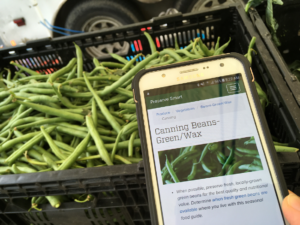
We’re at the height of the gardening season in Colorado, making it the perfect time to preserve delicious, ripe, local produce to enjoy throughout the winter months! Whether you have an abundance of tomatoes, cucumbers, blackberries, green beans or zucchini, be sure to select the best home food preservation method for YOU, and always use tested home food preservation recipes. It’s also critical that you make the recommended ‘high altitude’ adjustments for your kitchen, especially here in Colorado where we ALL live at high elevation! (Everything above 3,000 feet elevation is considered ‘high’ by the USDA.)
Why does elevation matter in home food preservation?
Water boils at a lower temperature as elevation increases (for example, at sea level water boils at 212 degrees F, while at 5,000 feet water boils at 203 degrees F). It is critical to know your kitchen’s elevation in order to make accurate food preservation adjustments that will destroy heat-resistant bacterium, such as Clostridium botulinum. Botulism is of the greatest concern for home canned foods and can cause severe illness or death. For those of us that cook in more than one kitchen (e.g. work, home, mountain get-away) it is important to remember to make the necessary adjustments specific to each location.
What elevation adjustments are needed?
The following are commonly increased as elevation increases in order to destroy heat-resistant bacteria and to ensure home-preserved food products are safe to enjoy:
- Processing time (for water bath canning fruits, fruit spreads, pickles, salsa and acidified tomatoes)
- Pressure requirement (for pressure canning vegetables, meats and all low-acid foods)
- Blanching time (for freezing and drying some foods, stopping the enzyme process to retain flavor, color, texture and nutrient content)
Not sure of the elevation of your kitchen?
Many smart phone’s include elevation information with their ‘Location’ tool. However, if yours doesn’t, use an elevation app or website like ‘What is my Elevation’ to determine your elevation:
website like ‘What is my Elevation’ to determine your elevation:
- Click on the link above.
- Select ‘ft’ as the unit of measure.
- Enter your street address, city and state.
- Write down your elevation in feet for your kitchen.
What is the best method of food preservation for YOU?
 Preserving foods at home can be fun, create a sense of pride and and possibly be economical. Using tested recipes you can also create unique food items you can’t buy. However, home food preservation can be costly and even fatal if not done properly. Four very important considerations before preserving food at home are:
Preserving foods at home can be fun, create a sense of pride and and possibly be economical. Using tested recipes you can also create unique food items you can’t buy. However, home food preservation can be costly and even fatal if not done properly. Four very important considerations before preserving food at home are:
-
Are there safe preservation guidelines and tested recipes available for the type of food you want to preserve and for the elevation at which you live?
- Before taking food preservation advice from friends and family, check with your State Extension service and/or the National Center for Home Food Preservation before preserving any food for the first time!
2. Do you have (or can you borrow) the necessary equipment for the preservation method?
- Read through the entire recipe before preserving a food product. Have all required to safely prepare, process and store the food.
3. How will you store the finished product?
- Canned foods require sturdy shelving in a cool, dry space that is out of direct sunlight. Protect home canned foods from extreme temperatures such as freezing or heat, which can cause jars to become unsealed.
- Frozen foods require freezer space that is maintained at 0º F or lower and with a dependable energy source.
- Dried foods are best stored in a cool, dry, dark place that is moisture- and rodent-proof.
4. How much will it cost to preserve the food and will you and/or your family like and use the finished product?
- What is the cost to purchase the unprocessed produce item and other ingredients?
- How much time and energy are involved in preserving the food?
- What will it cost to store the food?
- Can a comparable product be purchased for less?
- Do you and your family enjoy and benefit from eating or sharing the product?
Useful Home Food Preservation Resources
 ● The National Center for Home Food Preservation is your source for current research-based recommendations for most methods of home food preservation. The Center was established with funding from the Cooperative State Research, Education and Extension Service, U.S. Department of Agriculture (CSREES-USDA) to address food safety concerns for those who practice and teach home food preservation and processing methods.
● The National Center for Home Food Preservation is your source for current research-based recommendations for most methods of home food preservation. The Center was established with funding from the Cooperative State Research, Education and Extension Service, U.S. Department of Agriculture (CSREES-USDA) to address food safety concerns for those who practice and teach home food preservation and processing methods.
● Colorado State University Extension home food preservation fact sheets are available on its website.
● The Colorado State University Extension Preserve Smart App/website is a mobile-friendly resource for tested high altitude preservation recipes, a built-in elevation adjustment tool, and a comprehensive food preservation glossary.


Appreciate your feedback, Sheila!!
Excellent considerations and resources for the new or experienced home cook! Thanks Elisa